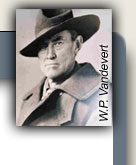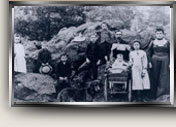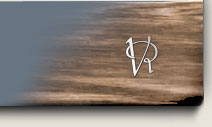William P. Vandevert did not buy his ranch in a single
transaction. He assembled it in pieces. The first two eighty acre
parcels, east of the Little Deschutes River, were land that his
brother Charlie bought to entice Bill back to Central Oregon from
New York State. Bill Vandevert had fallen in love with this land
when he had surveyed it earlier. Charlie sold the two parcels to
him for $600.
One of the eighty acre
parcels had belonged to a homesteader named Scoggin and the other
had belonged to a man remembered only as “Dutch John”. Scoggin had
a small house on his land and at least five acres in farmland.
The border between the
two eighty acre parcels went right near the spring. Scoggin
and Dutch John both thought they owned the spring or perhaps one of them owned
the land below the spring and felt entitled to the water flowing from it.
The more they thought about using the land, the more important the spring
became. There being a scarcity of law enforcement, courts, and judges in
the area, the two decided to settle their dispute by fighting a duel.
We don't know the details of the duel but Scoggin wound up shooting and wounding
Dutch John. Scoggin decided he needed to get help for his bleeding
neighbor.
In the version of the story told by Claude Vandevert the younger, Scoggin
rode
fifty miles to Prineville and to bring a doctor back. In
another version, Scoggin and his horse dragged Dutch John into Bend on a sled
used for moving stones. In either case Dutch John recovered and both men decided to sell or abandon their
properties and the spring. Scoggin moved to the
Willamette Valley.
Dutch John later
built a cabin near the future site of Bend. One day in the early
1900’s he simply disappeared. There were no lawmen in the area and
the matter was never investigated. Perhaps a new argument did not
turn out as well as the first one.
“We ate a lot of
mutton,” says Claude Vandevert. “Dad wouldn’t kill cattle. Cattle
were his crop.”
The other income from
sheep was selling the lambs in fall for slaughter. The new lambs
came in February and by fall they weighed eighty to ninety pounds
each. A ewe that hadn’t lambed was sold as well, though no one
would pay much for a ewe. Unlike the cattle, that went to range
near Spring River in the summer, the sheep stayed on the ranch
year-round.
The economic advantage
of sheep was that they would eat almost anything. They ate the
bunch grass that grew in the woods. Like deer they browsed the ends
of branches on bushes. In the winter they were fed the rye that was
stored in the barn. They stayed outside year round but received
double their usual feed if the weather was particularly cold. If it
snowed all night the sheep would walk around in the morning with a
foot of snow piled on their backs.
The sheep had to be
kept together and watched over to keep the coyotes from attacking
them. They were penned up near the Homestead at night. During the
day they went to pasture in the woods or most often to an area of
the ranch that the family called Cox’s Bend. It was the low land
near where the current barn is. Claude says there was a family
named Cox in the area and speculates that they had once camped in
that place. The sheep did not pasture on the rye fields after the
rye was harvested because the cattle would not eat pasture that
sheep had gone through. The sheep would eat the pasture unevenly
and leave their smell on the ground.
The job of shepherd
fell to Claude (the younger). Claude carried a fishing pole much
more often than he carried a rifle. The coyotes would stay hidden
when Claude was around and he rarely saw them. But once when he
forgot his lunch and went back to the house for thirty-five to forty
minutes the coyotes killed four sheep.
The big flocks came
from as far away as Grass Valley, Grant County, and Maupin. They
were on their way to summer range in the high lakes area of the
Cascades. Some turned west toward the mountains on South Century a
mile and a half south of the ranch. Others went further south to
Crescent and Davis Lake. When Claude was six or seven (in 1929 or
1930) about twenty to twenty-five flocks went by the ranch entrance
on South Century (what the family called “The Old Highway”). Flocks
were as big as 1,800 sheep. The smallest had 900 sheep. Every once
in a while a shepherd would leave a ewe at the ranch that was
struggling to keep up with the flock.
Claude Vandevert (the
elder) sold off all the cattle in 1940 or 1941 when the army took
over the Spring River range to build Camp Abbot. All the sheep were
sold at the same time. Claude went back into cattle in a minor way
after World War II ended in 1945 but chose not to raise any more
sheep.
All the years I was there (1930’s and 40’s), we had a vegetable garden. The latter years, it was just across the "big" bridge from the house (mostly washed out now) and it was about 125' by 30' in size. It was fenced in so the calves couldn’t get into it.
We had almost all the "root" veggies such as turnips, rutabaga, onions, parsnips, beets, and a few others. Those did very well except when the season was a bit cool and they were on the small size. Dad (Claude Senior) also put in potatoes and they grew to about the size of lemons - and were so good. We cooked them with the peelings on. We also had spinach, kohlrabi (sort of like cabbage in taste), and Swiss chard. What we didn't have were things like peas, corn, and green beans. We had to buy them at the store in cans. They were shipped in fresh to local stores. As far as where they got those last three in the olden days (before Bend was established), I'm not sure. I do know that the Redmond area had a warmer growing season and believe we obtained some of these vegetables from farmers down there. Uncle Bill lived at Tumalo and could grow some peas, I believe. We were almost 400 feet higher in elevation than he was. That made a difference. He was also able to grow strawberries and sold them - - so it was definitely warmer.
I don't even remember asking about gardens that were grown back when!! I would just think that Sadie would have grown everything she could get her hands on. They got their fruit each year from Willamette Valley area. They picked berries up around Taylor Bay and further south - - would go for over-night trips to gather them. They also got the wild plums from Summer Lake. I remember them, but barely remember going after them. Also, we would buy crates of things like apricots, pears, apples and can all that.
The best mushrooms we ever ate were back from the river on the west side in a meadow among the jack pine. They were huge and so tasty! Just one kind - - like the small ones you buy at the store - - white button type - -, but at the ranch, they grew quite large. We had one that was so big, it fit in a galvanized washtub and we took it to Bend to Mr. Cashman at his men's clothier store. He and Mr. Magill, the druggist, used to drive out to the ranch just to go pick them. Dad let them - - they were all close friends. We thought it was a great treat to have mushrooms - - Dad always did the cooking - frying them in a bit of bacon grease, and I can still remember how good they were! I'm not sure how long the growing season was.
Neighbors from as far away as La Pine came to the ranch to go
swimming in the Little Deschutes in the summer. At the north end of
the ranch, below the schoolhouse, the river made a turn to the left
where the inside of the turn was shallow and warm. This area had a
grassy meadow behind it and was easy to reach from the dirt road
that ran down from the front of the schoolhouse and over a small
bridge.
On the other side of
the river the current was faster and cut a deeper channel. The
Vandeverts built two diving boards there, one close to water level
and the other about eight feet high. The swimming area was
especially popular in the 1920’s and 1930’s when the Shevlin lumber
camp was only about two miles away on the east side of the Dalles-California
Highway.
Claude Vandevert
senior was running the ranch at that time. His brother, J.C., was a
doctor in Bend. (Dr. J.C. Vandevert’s desk is now in the Deschutes
County Historical Society Museum.) J.C. had a nurse named Dorothy
Veach whose husband was George Veach.
Scrambling for money
in the depression, Claude and George Veach thought they would put in
a dance floor near the swimming area and reap a little profit.
Claude and Pearl were good dancers and they liked to dance very much
themselves.
The band consisted of
four musicians. They didn’t practice together very much but they
were good amateurs. The pick-up band also played at the Grange in
La Pine and elsewhere in the area. They played currently popular
tunes for ballroom dancing. Claude Vandevert, the younger, says he
doesn’t remember any square dancing.
The dance floor was
about fifty yards northeast of the shallow part of the river. It
was about thirty-five feet on a side. The Vandeverts ran a
concession stand that sold hot dogs, candy, and gum. They stamped
the hands of those who had paid for admission to the dance floor.
Most people came as couples and then changed partners when the band
played a new tune.
People would come to
swim in the afternoon and stay to dance. Sometimes they would go
back and forth between swimming and dancing. As the evening grew
cooler people warmed themselves at bonfires set around the dance
floor. They stayed until around eleven or twelve at night.
The ranch saw three to
four dances each summer and people had some memorable times. But
some of the attendees drank so much they spoiled the fun for
themselves and others. The dances were only held for two years.
The Vandeverts may have brought in enough to pay musicians and pay
back the cost of building the dance floor.
Claude Vandevert,
born in 1923, lived and worked on the ranch until he was
twenty-five. He married in 1948 and moved to Bend where he worked
for companies in the automobile business, including Automotive and
Industrial Supply.
In the late 1960s
Claude’s father sold the ranch to Leonard Lundgren, the owner of
Lelco Mill and Lumber Company in Bend. Leonard was a customer of
Automotive and Industrial Supply. Claude switched companies and
worked for Leonard for about twelve years.
Claude took classes in
electronics and in 1961 went to work for Tektronix in Beaverton.
When Claude joined the company it had 6,000 employees. When he left
twenty years later it had 20,000. It was known as a good company to
work for and a good company to do business with. Claude now lives
in Forest Grove, about thirty miles west of Portland.
Claude says he had a
good life growing up on the ranch. He missed it after he left and
the ranch was sold. When Jim Gardner took a big interest in the
history of the ranch Claude was finally able to let go.
An Exceptional Horse
By Claude Vandevert
When I was about 8 or 9 years old, in 1931 or ’32, Dad's brother Bill decided I needed my own horse. So he gave me a colt named Pepper that his mare, Queen, had foaled that spring. Uncle Bill kept him for a couple years, broke him to ride, and then turned him over to me. Because Pepper was a quarter hot blood (a term we used for thoroughbreds), Dad wouldn't let me ride him for a couple years. Finally I felt that I could handle him and from that time on he was the only horse I rode. We spent a lot of time in the saddle because we had cattle to watch over and care for.
I can't give you any information about the lineage of Queen, Uncle Bill's horse, but I'm sure Uncle Bill was correct in saying that she was a descendant of Man o' War. Man O’War was born in 1917 and was voted the greatest United States trained thoroughbred racehorse of all time. Just after World War I, he won 20 of his 21 races. His descendants included Seabiscuit and War Admiral. One of Man O’War’s grandfathers happened to be called Bend Or. But Bend Or was a British horse that didn’t have anything to do with Bend or with Oregon.
I'm not sure about Queen’s other lineage--it could have been Arabian or quarter-horse. Uncle Bill raised thoroughbreds for several years and lineage was extremely important to him. So I suspect he could actually have traced Queen's lineage.
Pepper was what we called a strawberry roan; the red or bay color was faded to almost a pink and mixed with white. He had completely white legs to above the knees. He was not a big horse compared with the usual saddle horses used for riding after cattle. Even though he was small--perhaps 60 to 64 inches--he could pack a rider for 14 to 16 hours and accomplish a lot of work during that time. He was high-spirited and you had to be a good rider to stay with him. He never bucked, but when he would see a cow try to break away from the herd, he would take out after her before the rider even saw it.
Pepper had been well broken to ride but his spirit had never been broken. There was not a mean streak anywhere in him. One time we were trying to head off a cow that had broken away from the herd and he was on a dead run when all of a sudden he planted all four feet and slid to a stop. I was hanging on to anything I could grasp to stay with him. When we came to a stop, there was a wire stretched between two trees about a foot in front of my neck. He had seen it but I had not. From that time on we had a real love affair!
I never raced Pepper against another horse, but he was faster than other horses I had ridden. I have no idea how many generations he was removed from Man o' War, but I suspect several. He was born in the early '30s, so that would make possibly 13 or 14 years after his great sire.
During the winter, we turned the horses out of the ranch and let them fend for themselves in open range south of the ranch. Sounds like we didn't take care of them as we should have, but they always came out of the winter in better shape than if we had them closed up. The slough bottoms in the winter provided a lot of good feed for horses and it did save some of the harvested hay for the cattle. Hay was always in short supply for the winter feeding
The horses seemed to like to find their own food. Even when they were on the ranch, they sometimes didn't come to the barn area for feed. When the winter got too bad for them they would come home for a while and we would feed them.
I rode Pepper until in my late teens. One summer a horse raiser offered me $500 for him, but I told him Pepper was not for sale. The following winter was the last time we ever saw Pepper. We searched all over Central Oregon and had others looking for us all over the Northwest, but to no avail. The guy who had offered to buy Pepper had a pretty shady reputation. I always suspected him but of course couldn't prove anything.
To Top of Page
Dogs
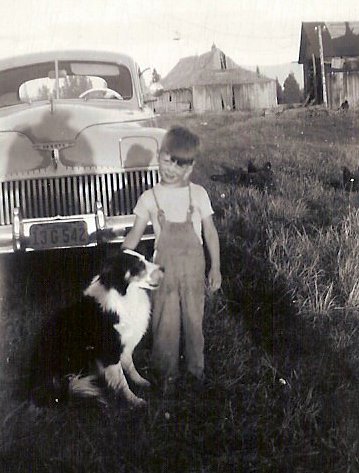 W.P. Vandevert kept
bear hounds for hunting but, over the history of the ranch, the
primary dogs were shepherds bred for herding cattle. The family
generally had one dog at a time and the working dogs also became
pets. The first was Tippy, a little brown and black female. The
second was Nick, a black and white male. The photo to the
right shows Nick with David Vandevert. The barn is in the
background and part of the garage is to the right. There was an Australian
Shepherd after that whose name is lost to history.
W.P. Vandevert kept
bear hounds for hunting but, over the history of the ranch, the
primary dogs were shepherds bred for herding cattle. The family
generally had one dog at a time and the working dogs also became
pets. The first was Tippy, a little brown and black female. The
second was Nick, a black and white male. The photo to the
right shows Nick with David Vandevert. The barn is in the
background and part of the garage is to the right. There was an Australian
Shepherd after that whose name is lost to history.
The dogs worked mostly
in the summer and were particularly important driving the cattle to
and from their summer range at Spring River, west of Sunriver.
Claude Vandevert senior moved the cattle to the summer range in
May. Some of the cattle didn’t want to leave the ranch, especially
the younger ones who didn’t know where they were going. As the
herd moved along, individual cows started to wander off on their
own. The men on horseback would sic the dog after them. Tippy or
Nick got in front of the cow, barking and snapping, until the cow
turned its head and ambled back to the herd. It meant the men on
horseback could direct the herd without having to chase after the
errant cows.
In the fall some of
the cows headed for the ranch early on their own. But cows with
calves were reluctant to make the move.
There wasn’t a lot of
need for the dog in the summer because the cattle were
free-ranging. At the ranch in the winter, with the cattle fenced
in, there was almost no work for the dog at all.
The dogs were not
allowed in the house, though they sometimes stuck their noses in the
door. They lived off table scraps and what they could find on their
own - often deer and other animals that had died. The dogs liked
chasing sage rats but they were not very successful at catching
them. When they couldn’t find things to eat Pearl made up some
coarse bread with bacon fat or cracklings from rendering fat out of
beef.
Tippy and Nick were the "doorbell"
to the ranch. Anyone coming through the front gate set the dogs
barking. The family was usually gathered in the back of the house
near the kitchen and dining room and would not be aware of a car
driving into the ranch without the dogs.
The dogs were never on
a leash and enjoyed the freedom to go and do what they pleased.
They had a good life.
To Top of Page
Music
Claude
Vandevert, son of W.P. Vandevert, worked in Portland for a few years
before marrying Pearl Catlow. He loved music in general and opera
music in particular. He and Pearl brought lots of twelve-inch 78
RPM records with them when they moved to the ranch. Claude
influenced his family with his love of music.
A friend and neighbor who lived
near where the Harper Hotel had been, Lois Maker Gompert, came to
the house in the 1930’s for an evening of music. Her father played
a banjo and other instruments while Lois played the piano. Johnny
Brasel (Dorothy Vandevert’s brother) played the saw. He placed a
regular cutting saw across his knee and used a bow to play it. Lois
could and did play up a storm. She still plays piano for the Kiwanis
Club in Bend every week.
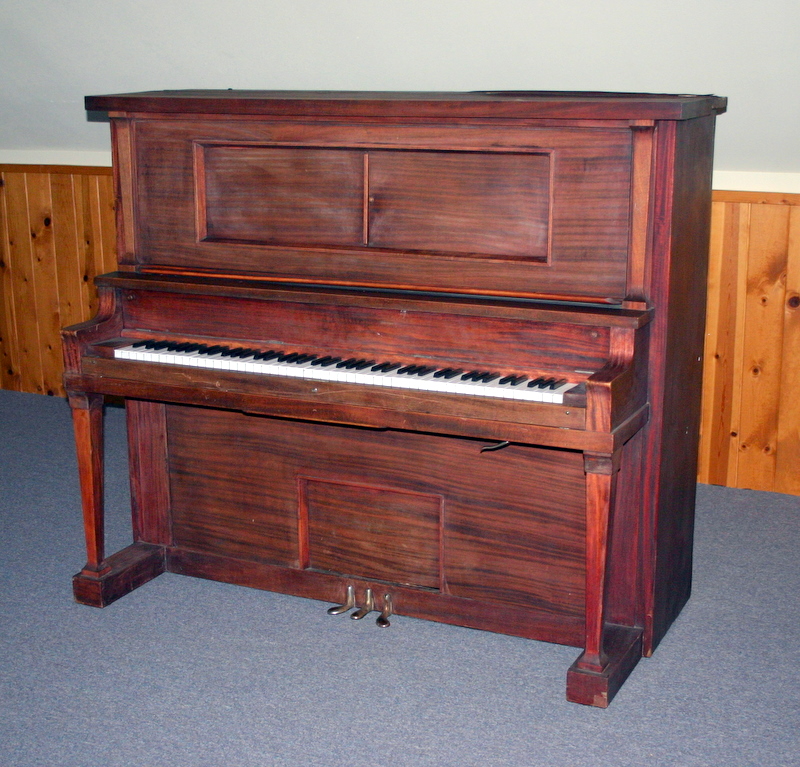 Music was always around the house
either from the battery radio, the phonograph or someone playing the
piano. The records included Hawaiian music and Sousa marches.
Grace was partial to the music of the late 30's & 40's (Como,
Sinatra, etc.) and the big bands of the day. At first the family
had a tall phonograph that had the turntable in the top and a big
lid that came down. In the bottom part, there were shelves for
records. In later years - in the 30's – Claude’s brother gave the
family his phonograph that was built like a table and also had room
in the bottom for records. It is still in the family.
Music was always around the house
either from the battery radio, the phonograph or someone playing the
piano. The records included Hawaiian music and Sousa marches.
Grace was partial to the music of the late 30's & 40's (Como,
Sinatra, etc.) and the big bands of the day. At first the family
had a tall phonograph that had the turntable in the top and a big
lid that came down. In the bottom part, there were shelves for
records. In later years - in the 30's – Claude’s brother gave the
family his phonograph that was built like a table and also had room
in the bottom for records. It is still in the family.
Sometimes on Sunday
evenings Pearl played the
piano. The family would gather around and sing songs. Claude
Vandevert says it was a great way to grow up. The kids had good
relationships with each other and with their parents. They were
poor as church mice but didn’t know it. The family piano
was acquired by the Vandevert Ranch Association and has a place of honor in the
meeting room on the second floor of the barn.
To Top of Page
Christmas at the Ranch, 1930’s
By Claude Vandevert and Grace Vandevert McNellis
Christmas brought the wider family together at
the Old Homestead. It was quite a strain on our Mother, but she
always looked forward to it and wanted it to happen. She liked lots
of company and so did Dad.
In 1934, however, our mother had higher
priorities than her guests. Our sister, Mary Jean was born on the
ranch the afternoon of December 24th. Our mother was in her bed at
the south end of the downstairs. Christmas Eve was held in the
living room, just across a hallway, so she could almost feel part of
the group. Even though there had been a birth, there was still a
house full of people. At least Mom didn't have to provide meals for
them. That year they cooked for her.
Grace was only five years old that year. We
went down to school that day and when we got home in the afternoon,
there was a baby sister. Grace was thrilled with her and thought
she was her Christmas doll. Mary Jean was a red-head and very cute.
Our folks had little to purchase presents.
They were usually very practical presents like
clothing and such, but usually at least one
thing that we really wanted. Christmas plans started in November
when we would receive the Montgomery Ward’s Christmas catalog.
Everyone got a chance to go through the catalog and make notes of
what they wanted. That didn’t mean they would get what they picked
out, but there was always chance.
When Mary Jean was old enough to walk, she went
with our mother and Grace to J.C. Penney’s store in Bend. All the
toys were in two or three aisles in the basement. We would walk
through and look at every one of them. Penney’s would even let us
try out the tricycles in the aisles.
Meantime, Grace and her mother made gifts for
the aunts, uncles, and cousins that lived away and mailed them off.
They were embroidery works on pillowcases and tea towels and also my
mother’s wonderful fruitcakes. Dad raised several turkeys for the
family and may have sold some to neighbors at Christmas. If Dad
did, it was not a business. Maybe that helped pay for some of our
presents.
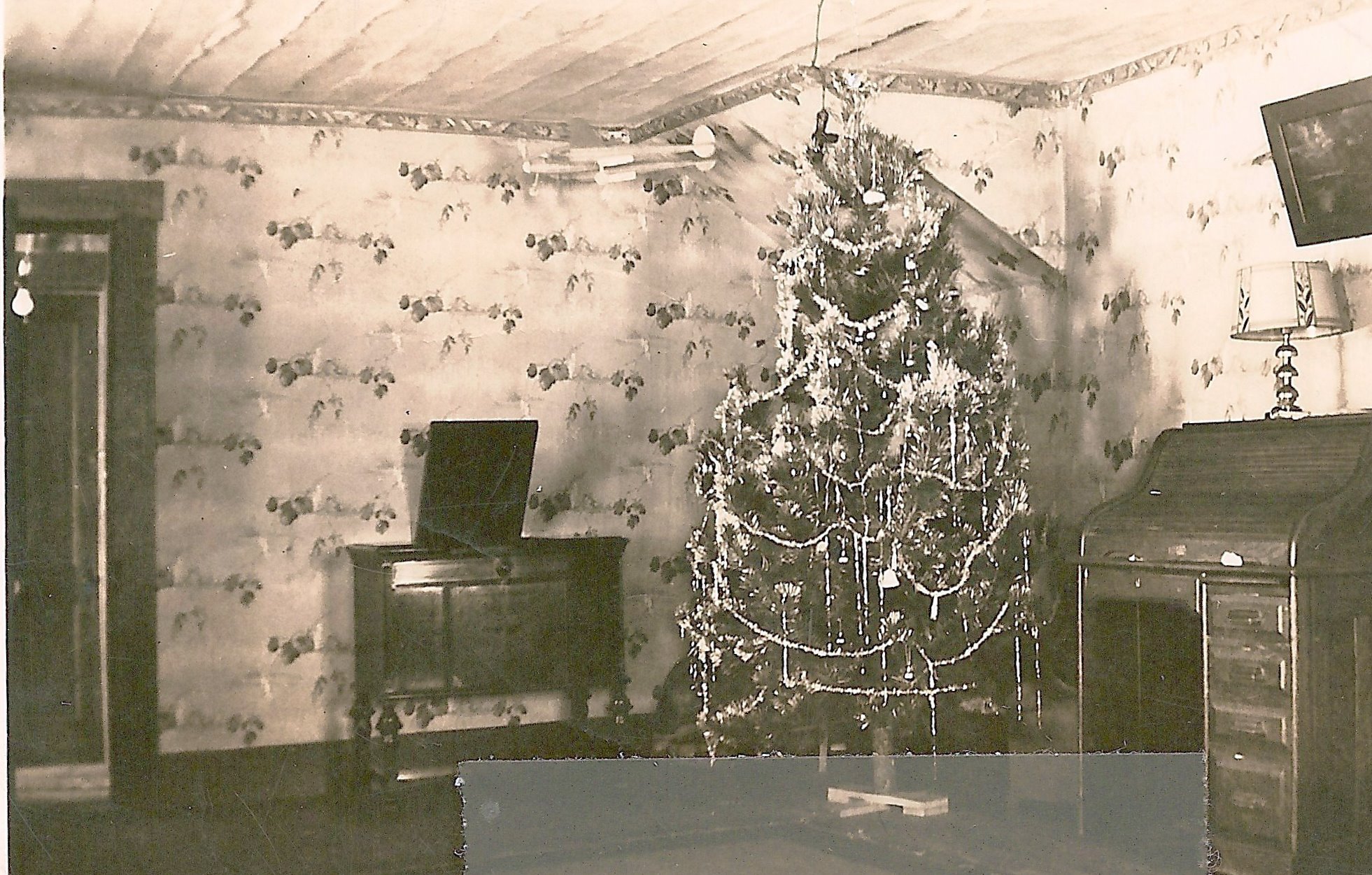 On the Sunday before Christmas we would cut the
tree. The family would all go out. The tree was usually a
lodgepole pine from just north of the rock pile at the entrance
gate. Dad probably pruned up several trees during the year to make
them look better for Christmas. Sometimes the family would drive up
to the cattle’s summer range, by Spring River, and go up a little
higher in the hills to pick the tree. The tree was decorated with a
boxful of ornaments that had been used for years. See the photo
from Christmas 1940 and notice the model airplane up and to the left
of the tree. The light bulb in the hall is significant because
either 1939 or 1940 was the
first Christmas with electricity (from the Kohler generator).
On the Sunday before Christmas we would cut the
tree. The family would all go out. The tree was usually a
lodgepole pine from just north of the rock pile at the entrance
gate. Dad probably pruned up several trees during the year to make
them look better for Christmas. Sometimes the family would drive up
to the cattle’s summer range, by Spring River, and go up a little
higher in the hills to pick the tree. The tree was decorated with a
boxful of ornaments that had been used for years. See the photo
from Christmas 1940 and notice the model airplane up and to the left
of the tree. The light bulb in the hall is significant because
either 1939 or 1940 was the
first Christmas with electricity (from the Kohler generator).
In the late afternoon of Christmas Eve, Uncle
Bill and Aunt Dorothy arrived with our cousin Barbara from the
Paulina Ranch. Aunt Maude’s family came from the Shevlin Camp or La
Pine with their daughter, Kathryn, who was older than we were (born
1918). Sometimes Kathryn’s older siblings, Bill and Betty, also
came on Christmas Eve or on Christmas day.
Since the 24th was also our sister
Mary Jean’s birthday, we gathered in the kitchen for a light supper
and Mary’s birthday cake and presents. We made sure she had her
special time even with Christmas on our minds! Then we retired to
the living room where the family exchanged gifts.
The children all received gifts such as jig-saw
puzzles, card games, Monopoly, marbles, jacks, and many other fun
things. Gracie remembers receiving autograph books. But her
favorite gift from those days was a Brownie Box Camera that her
brother Claude gave her. I loved that camera and took many pictures
over the years that I still have. (Some are on this web site!)
We finished up about ten o’clock and, in most
cases, the visiting family stayed at the ranch overnight. The next
morning Uncle Bill and Johnny Brasel (Aunt Dorothy’s brother) would
go back to Paulina Ranch to milk the cows and take care of the
chores before they returned. The kids arose early and ran to see
what Santa Claus has left for them in the stockings by the old
fireplace. Usually, a very special toy was there that had been
yearned for in the catalog or the store and the rest was filled with
nuts, candies, new toothbrushes, socks, and many other things.
During the morning, the women shared the work
of putting the Christmas dinner together. We all waited for Uncle
Doc (Clint Vandevert) and Aunt Harriet, Joan and Jack to arrive from
Bend. Aunt Harriet brought more things for dinner. Then the men
put the large table together in the dining room that would seat at
least 20 people, and we sat down to the big turkey dinner with all
the trimmings. In those days we made everything from scratch
because, with no refrigeration, we couldn’t store things. It all
worked beautifully and we sat there for well over an hour eating and
enjoying every minute. Uncle Bill got his special pan of boiled
parsnips that he loved.
Grampa (William Plutarch Vandevert) sat at one
end of the table. He must have taken great satisfaction celebrating
Christmas in a house that he had built, on a ranch he had founded,
surrounded by four of his eight children and many of his
grandchildren. He talked and listened to everyone and then retired
to the living room by the fireplace to continue with the men while
the women cleaned up.
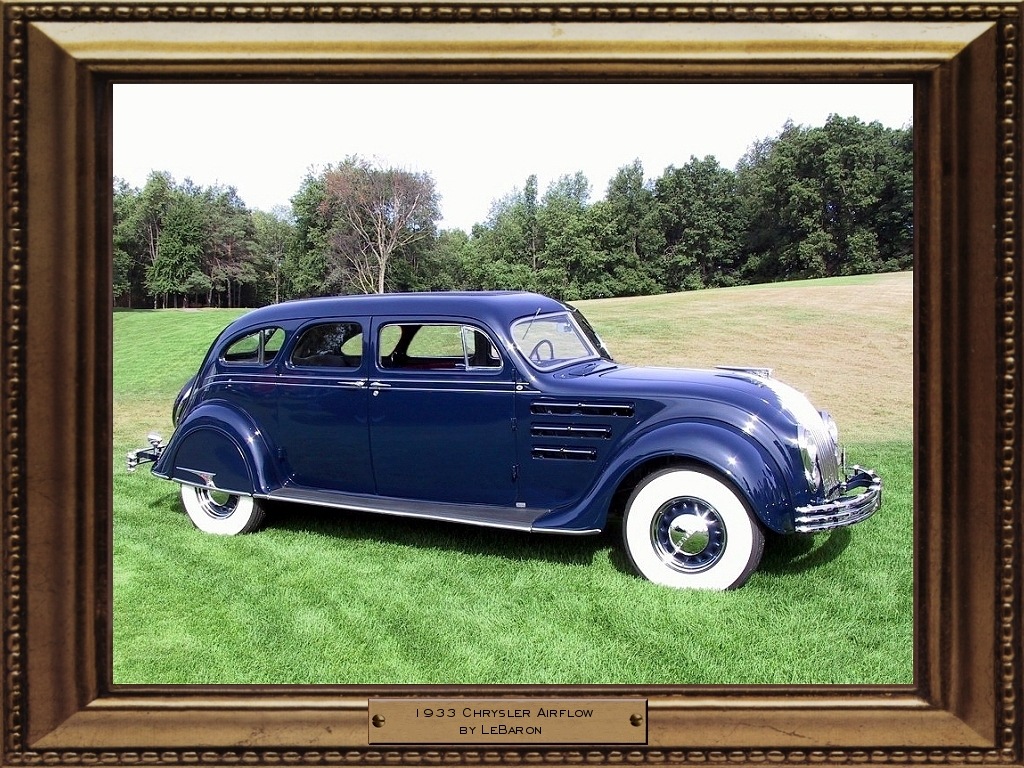 Another special Christmas was either 1935 or
1936. About 4 PM on Christmas Eve, Dad and Claude went to the barn
to feed the cattle and milk the cow. It was snowing quite hard but
we forgot about it and went ahead with the festivities. About 10 PM
Dad's brother Uncle Doc said he thought he had better back to Bend
and would return for dinner the next day. He had just purchased a
Chrysler Airflow. (The modern photo is of a restored Airflow, not
Uncle Doc’s). Well, when we went outside, there was two feet of
fresh snow. No going home for anyone that night. So my Mother had
to put up about twenty people for the night, make breakfast the next
morning, and provide lunch for them while Dad and Claude and the
other men worked the better part of Christmas day opening up the
road to Highway 97 so everyone could go home. And can you believe
it? Our mother always spoke of that time with great fondness.
Another special Christmas was either 1935 or
1936. About 4 PM on Christmas Eve, Dad and Claude went to the barn
to feed the cattle and milk the cow. It was snowing quite hard but
we forgot about it and went ahead with the festivities. About 10 PM
Dad's brother Uncle Doc said he thought he had better back to Bend
and would return for dinner the next day. He had just purchased a
Chrysler Airflow. (The modern photo is of a restored Airflow, not
Uncle Doc’s). Well, when we went outside, there was two feet of
fresh snow. No going home for anyone that night. So my Mother had
to put up about twenty people for the night, make breakfast the next
morning, and provide lunch for them while Dad and Claude and the
other men worked the better part of Christmas day opening up the
road to Highway 97 so everyone could go home. And can you believe
it? Our mother always spoke of that time with great fondness.
To Top of Page
The Allen Ranch and the West Property
In the era of the Vandevert Family, the land
that is now Crosswater was owned by the Allens and rented for some
of the summers by the Elliotts. The following letter was written by
Mildred Elliott West to Grace Vandevert McNellis and the photos were
supplied by Mrs. West. (Text in parantheses is by the editor from
notes by Mrs. West.)
Walla Walla, Washington
November 30, 2007
Dear Mrs. McNellis:
Sorry to be so slow in answering
your nice letter. I spent very little time at the river this year –
I was not able to find the pictures I wanted but I am enclosing some
that I found.
I was only five years old when my
father rented the Allen ranch for the summer (of 1921). My father
was the livestock manager for the bank. The sheep had to be dipped
before entering the National Forest. The Little Deschutes seemed to
be the dividing line. My sister and I had happy memories of summers
we spent on the Little Deschutes. (Sheep dipping is getting
underway on the east side of the river in the first photo below.)
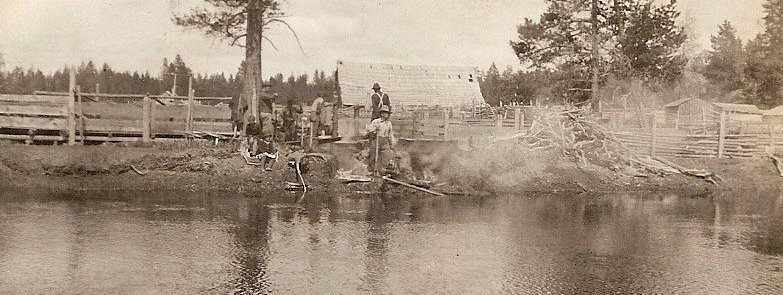
(In the second photo, taken from the west side
of the Little Deschutes, the bridge is where the current bridge is
near the Crosswater entrance and the ninth tees. The men on either
side are counting the sheep as they cross into the National Forest
for summer grazing.)
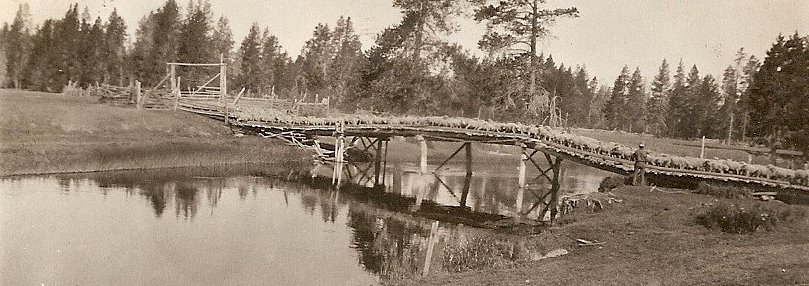
(The third photo shows
the sheep on the west side of the river before moving off toward the
National Forest in the mountains. There is a large hay barn in the
distance.)
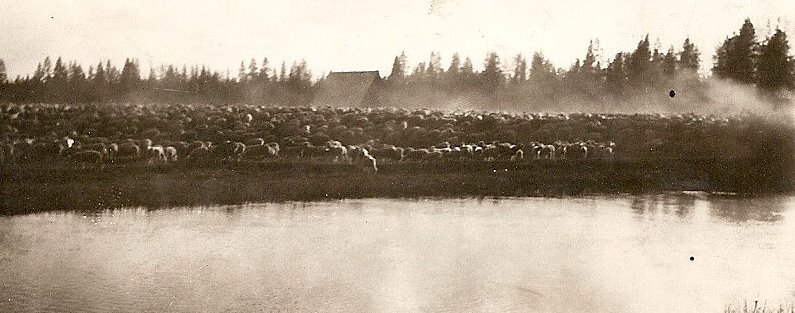
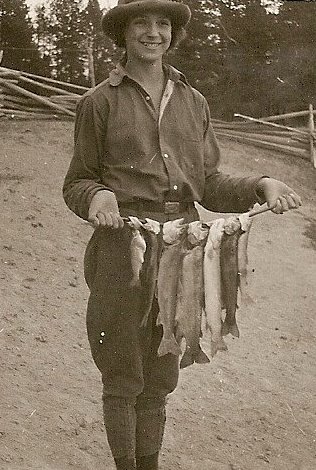 My
sister, Mable Elliott (in photo with fish), graduated from Bend High
School in 1925. I graduated from Redmond High in 1934. I lived at
Powell Butte until I was married. My mother continued to live there
until her death. My father died in 1935.
My
sister, Mable Elliott (in photo with fish), graduated from Bend High
School in 1925. I graduated from Redmond High in 1934. I lived at
Powell Butte until I was married. My mother continued to live there
until her death. My father died in 1935.
My husband, Edward
Wade West, and I purchased 200 acres along the big Deschutes in
1955. We spent our vacations there until we built our house in
1970. He retired from his work in southern California.
My father-in-law, Conrad Prior
West, was a native Californian. He spent his summers at our place
on the river. He was acquainted with many people along the river.
He enjoyed visiting with the people. He returned to California when
the weather turned cold. He had eight children all living in
California except Wade. Conrad died in California October 11,
1976.
We bought the river ranch from Mr.
and Mrs. William James. They were building a chicken ranch and were
enlarging it when he became allergic to chickens and needed to sell
his ranch. Later we sold 100 acres to a man from California. He
sold it to a developer who started Water Wonderland!! I wish we
would have had more foresight.
My husband died in 1994 so I only
spend part time at the river. It seems to be less time each year.
I’m hoping to go for a longer “visit” this coming year. I still
have my driver’s license if needed. The drive from Walla Walla to
Crosswater is a little long for me.
Sincerely,
Mildred West
To Top of Page
Bend High School in the 1940's
By Grace V. McNellis
I attended Bend High School for eighth grade through twelfth, from September 1942 to graduation in 1947. For my first two years I lived with a family on Drake Road because there was no school bus from the ranch and it was too far for Dad to drive every day. One year David and Mary Jean lived in the same house with me. In the third year I lived just a block towards the Newport Bridge in another home.
I worked for my room and board as the couple owned the local bowling alley and needed to be gone in the evenings. I took care of their little girl. Drake Road had some really nice homes in those days. Tom Brooks and his family lived there. They owned the Brooks-Scanlon Mill. My Uncle George and his family lived there for several years in the late 1920's and that house is still there. I lived next door to a local dentist whose daughter I'm in touch with all the time. We graduated together. Great memories!!
My Uncle Doc (Dr. J.C. Vandevert) lived on Brooks Street just to the south of Pine Tavern. He was a very respected doctor and he was a favorite uncle of all of us. He took time to chat with us when we had to come to his office although we were told not to bother him by my Mother. He always had a few people in his waiting room and when we went into his surgery, he would pick me up and set me on his surgery table and start asking questions about the ranch - how was the fishing - how many new calfs this spring - and so on. I realize now that Uncle Doc was a very young man when he first came there and he had to help with the ranching just like Claude, Dave and me! The house had the most beautiful ponderosa pines and one huge weeping willow tree on the lawn that ran right down to the river. It was gorgeous. The house was a hospital to start and then a wonderful home when Uncle Doc lived there. It was huge! At least in those days it was. They tore the house down and made a parking lot out of it about 25 years ago after Uncle Doc died. We hated that!
The war was on while I was at Bend High in my 8th thru 10th grade, so we said goodbye to some of the senior boys who joined the service. It was a rare time. When I turned 15, my Dad gave me permission to donate blood to the war cause. I did this once a month, I believe, and felt very good about it. They had a place to do this on Wall Street and, I think, they had a building set aside to handle it. I felt very patriotic!
Location
The Bend High School building is still there - and is just across Wall Street (right downtown) from the new library that was built about seven years ago. (See map at end of this article.) The building goes all the way through to Bond Street and is a two story building with lots of stone work. The next large building to the south was our gymnasium and is now a recreational building of some kind. It was built many years ago and still stands. Then, just to the south of that building is the Historical Society which was the Reid School when my sister Mary Jean was young. She went there for a couple of years.
Those three buildings are all beside each other. Claude would pick me up at the high school on Bond Street side and then we would pick Mary Jean up at the Reid School next door. It worked out well.
Football and Basketball
During the school year, we had football season in the fall and basketball in the winter time. The high-school football games were always on Friday nights. The field was located close to 3rd Street & Franklin Ave. The railroad tracks ran around the south end and west side of the field. There were no other buildings in that area except on 3rd street so there was lots of room for parking and the field. We had two large grandstands - one on either side of the field.
We usually walked to the game as no one had cars. But Bend was a lot smaller then and the students lived either on the west side of the river or the east. They walked everywhere and were used to it. It was the same for the basketball games held at the old gym next to the high school
It was always cold before the football games were over so we wore warm clothing. Girls didn't wear slacks in those days - we wore bobby sox and saddle shoes - so sometimes we remembered to bring blankets for warmth.
After the games, both football and basketball, we walked downtown to Oregon Ave. where there was in ice cream store called Kessler's. We would gather for an hour or so and then start for home. By that time, it would be 10:30 or 11:00 and it was even colder outside.
When we were kids at both La Pine & Bend schools, we always stayed with a friend after school if there was to be a game played - - then the folks would come to the game and we would go home together afterwards. That stopped after our Mother died in 1942.
Cars and Jaunts
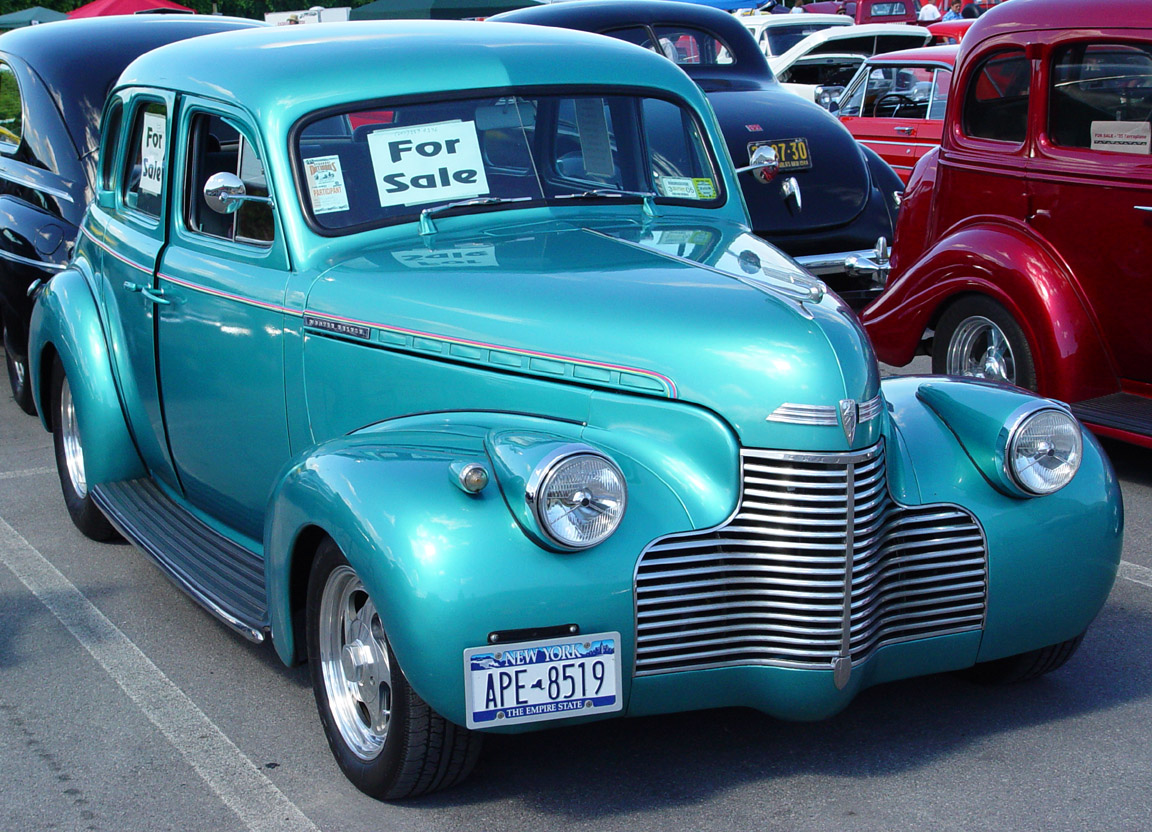 When I was 15 and a sophomore, I was given a car by the school district at the ranch. It was because they couldn't afford to have the Bend School district send a bus out to pick us up and take us home each day. So I had a special license and drove the 1940 Chevrolet 4-dr car with my sister to school in Bend. (The restored 1940 Chevy in the photo is similar except Grace’s car was dark green. Note that the rear doors were hinged at the back. – ed.) The gear shift was on the steering wheel which I thought was wonderful - - not on the floor! It was a very good car. After I graduated, Dad had the car and, I think, Claude bought it from the school district and used it for a few years.
When I was 15 and a sophomore, I was given a car by the school district at the ranch. It was because they couldn't afford to have the Bend School district send a bus out to pick us up and take us home each day. So I had a special license and drove the 1940 Chevrolet 4-dr car with my sister to school in Bend. (The restored 1940 Chevy in the photo is similar except Grace’s car was dark green. Note that the rear doors were hinged at the back. – ed.) The gear shift was on the steering wheel which I thought was wonderful - - not on the floor! It was a very good car. After I graduated, Dad had the car and, I think, Claude bought it from the school district and used it for a few years.
Also, when we had a car to use after the games, we would go out Hwy 97 approximately across from the Hong Kong Restaurant that is still there now, at the corner of 3rd and Wilson, to a drive-in called The Skyline Drive-In. (See map at end of this article). The Skyline was a small white building with lots of windows and lots of parking space. They had marvelous milk-shakes and hamburgers. We would go in to order and sometimes eat in the small booths and have a great time discussing the latest. But lots of times we took our hamburgers and drove around with whoever had a car. That was great fun! Our cars would be loaded with kids, so, somehow, we drove carefully and never got in trouble! We were very lucky kids!
Since I had a car a lot of the time I drove to the Friday games and then drove back to the ranch after going to Kessler's or the Youth Club we had called "The Bear's Den" right across the street from Kessler's. I would drive home after delivering my girl friends home. I always drove home in the time that was allotted to me by Dad and I never gave him reason to worry. I just couldn't do that. He gave me a lot of room to grow up in those days.
Once in a while, I would stay overnight with a friend and then drive home on Saturday morning to the ranch. If I stayed in Bend overnight, I usually did some grocery shopping on Saturday and then left for the ranch. There were always chores waiting at home and Dad was by himself. He was so very good to me about all those things. I never thought to do anything he would disapprove of.
It was when I returned to my 25th Graduation Reunion that I found out how lucky I was to have had a car in those days. The boys were totally enthralled with the idea that I could do that and they didn't even own a car. Gas was rationed and it was hard times, but I remember it all so well.
I never knew how much my car was envied by the boys. There was one fellow who asked if he could just sit in my car and eat his lunch! Figure that one out! Of course it was fine with me. His father bought one of the first new cars made after the war and I can't remember the name of it - - would it have been a Hudson? He drove it out to the ranch to show it to me and to my Dad. All I remember is that it was very big compared to our Chevies. Dad had a '41 two-door that he bought in 1941 - used - and it was special when I got to drive it to school. Unlike the 1940 Chevy it had a radio! So, when I got to drive Dad's car, I was in heaven as I was a music nut in those days. The radio was for listening to all the latest song hits and to know all the words. My sis and I loved that!
I once managed to wreck the 1940 car - - went off the icy road on way to school right where the Sunriver exit is. While getting it fixed, Dad made me drive in his car every day so I wouldn't be scared to do it! What a guy!
When it got to be cold and snowy, we moved into Bend to a friend's home and stayed until the weather changed. (See Grace's description of first and second grade on the ranch in Harper School Recollections.)
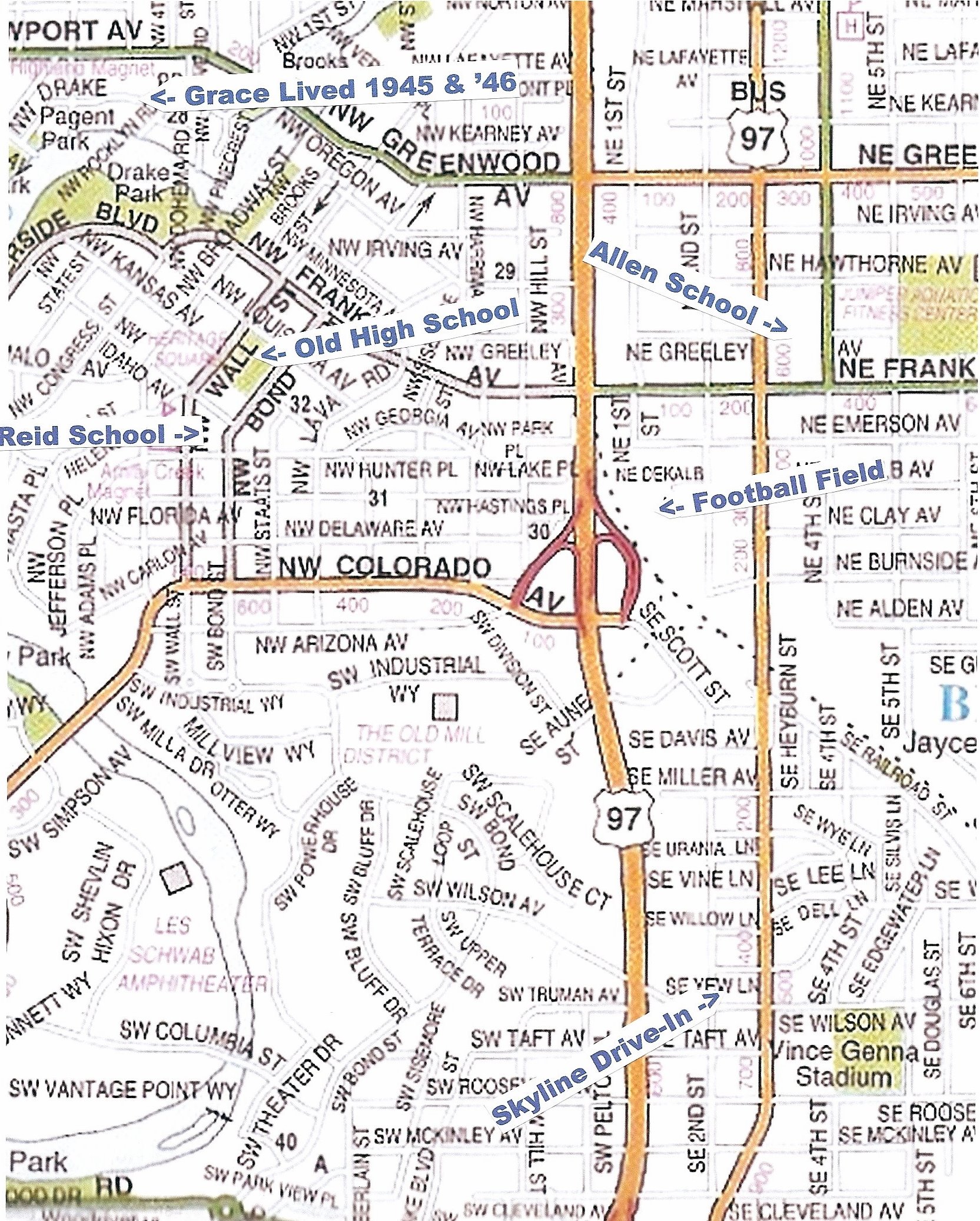
To Top of Page

